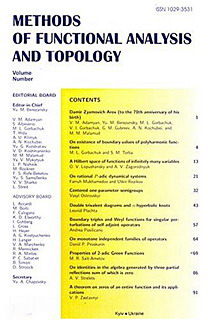V. D. Koshmanenko
orcid.org/0000-0003-0411-4059
Search this author in Google Scholar
Point spectrum in conflict dynamical systems with fractal partition
V. Koshmanenko, O. Satur, V. Voloshyna
MFAT 25 (2019), no. 4, 324-338
324-338
We discuss the spectral problem for limit distributions of conflict dynamical systems on spaces subjected to fractal divisions. Conditions ensuring the existence of the point spectrum are established in two cases, the repulsive and the attractive interactions between the opponents. A key demand is the strategy of priority in a single region.
Fixed points of complex systems with attractive interaction
MFAT 23 (2017), no. 2, 164-176
164-176
We study the behavior of complex dynamical systems describing an attractive interaction between two opponents. We use the stochastic interpretation and describe states of systems in terms of probability distributions (measures) and their densities. For the time evolution we derive specific non-linear difference equations which generalize the well-known Lotka-Volterra equations. Our results state the existence of fixed points (equilibrium states) for various kinds of attractive interactions. Besides, we present an explicit description of the limiting distributions and illustrate abstract results by several examples.
Dynamical systems of conflict in terms of structural measures
Volodymyr Koshmanenko, Inga Verygina
MFAT 22 (2016), no. 1, 81-93
81-93
We investigate the dynamical systems modeling conflict processes between a pair of opponents. We assume that opponents are given on a common space by distributions (probability measures) having the similar or self-similar structure. Our main result states the existence of the controlled conflict in which one of the opponents occupies almost whole conflicting space. Besides, we compare conflicting effects stipulated by the rough structural approximation under controlled redistributions of starting measures.
Existence theorems of the ω-limit states for conflict dynamical systems
MFAT 20 (2014), no. 4, 379-390
379-390
We introduce a notion of the conflict dynamical system in terms of probability measures, study the behavior of trajectories of such systems, and prove the existence theorems of the ω-limit states.
Nonzero capacity sets and dense subspaces in scales of Sobolev spaces
Mykola E. Dudkin, Volodymyr D. Koshmanenko
MFAT 20 (2014), no. 3, 213-218
213-218
We show that for a compact set $K\subset{\mathbb R}^n$ of nonzero $\alpha$-capacity, $C_\alpha(K)>0$, $\alpha\geq 1$, the subspace $\overset{\circ}{W}{^{\alpha,2}}(\Omega)$, $\Omega={\mathbb R}^n\setminus K$ in ${W}{^{\alpha,2}}({\mathbb R}^n)$ is dense in $W^{m,2}({\mathbb R}^n)$, $m\leq\alpha-1$, iff the $m$-capacity of $K$ is zero, $C_{m}(K)=0$.
On fine structure of singularly continuous probability measures and random variables with independent $\widetilde{Q}$-symbols
S. Albeverio, V. Koshmanenko, M. Pratsiovytyi, G. Torbin
MFAT 17 (2011), no. 2, 97-111
97-111
We introduce a new fine classification of singularly continuous probability measures on $R^1$ on the basis of spectral properties of such measures (topological and metric properties of the spectrum of the measure as well as local behavior of the measure on subsets of the spectrum). The theorem on the structural representation of any one-dimensional singularly continuous probability measure in the form of a convex combination of three singularly continuous probability measures of pure spectral type is proved.
We introduce into consideration and study a $\widetilde{Q}$-representation of real numbers and a family of probability measures with independent $\widetilde{Q}$-symbols. Topological, metric and fractal properties of the above mentioned probability distributions are studied in details. We also show how the methods of $\widetilde{P}-\widetilde{Q}$-measures can be effectively applied to study properties of generalized infinite Bernoulli convolutions.
The infinite direct products of probability measures and structural similarity
MFAT 17 (2011), no. 1, 20-28
20-28
We show that any similar structure measure on the segment $[0,1]$ is an image-measure of the appropriate constructed infinite direct product of discrete probability measures.
Origination of the singular continuous spectrum in the conflict dynamical systems
MFAT 15 (2009), no. 1, 15-30
15-30
We study the spectral properties of the limiting measures in the conflict dynamical systems modeling the alternative interaction between opponents. It has been established that typical trajectories of such systems converge to the invariant mutually singular measures. We show that "almost always" the limiting measures are purely singular continuous. Besides we find the conditions under which the limiting measures belong to one of the spectral type: pure singular continuous, pure point, or pure absolutely continuous.
Dynamics of discrete conflict interactions between non-annihilating opponents
Sergio Albeverio, Maksym Bodnarchuk, Volodymyr Koshmanenko
MFAT 11 (2005), no. 4, 309-319
309-319
Dense subspaces in scales of Hilbert spaces
S. Albeverio, R. Bozhok, M. Dudkin, V. Koshmanenko
MFAT 11 (2005), no. 2, 156-169
156-169
Fine structure of the singular continuous spectrum
Sergio Albeverio, Volodymyr Koshmanenko, Grygoriy Torbin
MFAT 9 (2003), no. 2, 101-119
101-119
A variant of the inverse negative eigenvalues problem in singular perturbation theory
MFAT 8 (2002), no. 1, 49-69
49-69
Generalized eigenfunctions under singular perturbation
S. Albeverio, V. Koshmanenko, K. A. Makarov
MFAT 5 (1999), no. 1, 13-28
13-28
Lippmann-Schwinger equation in the singular perturbation theory
S. Albeverio, J. F. Brasche, V. Koshmanenko
MFAT 3 (1997), no. 1, 1-27
1-27

